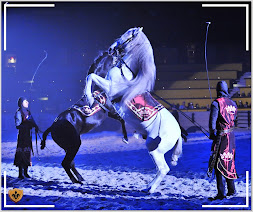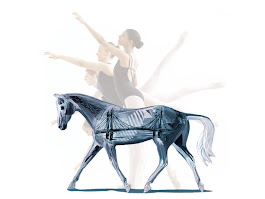|
Medieval Times Dinner Theater
Equi Partner~Mario A. Contreras
 CAN YOU SAY DREAM JOB! Horses and entertainment go hand in hand with Mario and his team. Medieval Times has been voted the number one dinner theater in the United States and this year is celebrating its 50 million guests nationwide.
 | |
Mario A. Contreras & Diamanté MT~talented 7 yr old Andalusian Stallion who Mario uses for his solo act.
|
Medieval Times has one of the largest breeding farms of Andalusians in the United States. Chapel Creek Ranch is located in Sanger,Texas. All of the Andalusians that you see in the shows are bred, raised and broke to ride at the ranch and then hand selected to go to one of the various nine castles located in the United States and Canada. Each castle has between 20 and 30 horses. There are other various breeds of horses that you will see in the show for the games, but the horses that are used for the Alta Escuela and the Airs Above The Ground are all Andalusians from the ranch. At three years of age the Andalusian stallions are sent to the castles. The first three to six  months are dedicated to ground work and breaking the horses to ride. The horses take time getting used to their new environment by lunging and being worked on long lines. The horses need to get used to the various sounds and lights that are a part of the show. We want to make sure that each horse has a very solid foundation because this is what the horse will be doing for the next ten years. It is important for the riders and horses that this process is done correctly and patience and time are given to the horses. The term "bomb proof" is a commonly said about our horses. Our stable in Chicago is just like a regular barn. The farrier, the stall cleaning, turn out, lesson schedules are all part of the daily routine. The only difference is the shows that are put on in the evenings.
I use the most experienced riders to help me break the horses. In this particular castle we have 25 horses and a team of 20 riders. We use an average of 13 horses in the show and our plan is always to have a back-up horse for every part of the show. The introduction to the show for the Andalusians is the Carousel. This is a routine of eight horses doing a five minute synchronized drill. This is also where the horses get used to their costumes and the 8 ft poles with flags that the riders carry. We use a Classical Dressage approach to this routine along with a mixture of Doma Vaquera Espanola.  After a good solid year of this I start to pick the horses that are going to be the horses used in long lines. These horses are used to demonstrate the Airs Above The Ground such as the levade, cabriole and hind walk. They also demonstrate the Alta Escuela (High School) manuevers such as passage, piaffe, and Spanish Walk in long lines. Horses are all indviduals and some of them take longer then others to learn or to adapt to their new jobs at Medieval Times.
For the Medieval Games, the jousting, the horse back fights and the stunts that we do with  falling off the horse at full speed and the roll outs, we use Quarter Horses and Aztecas. Our goal in each castle is to put Andalusians in every part of the show and this is something that we hope will happen in the near future. The training of the riders is done so that the riders can adapt themselves to our program and style of riding. We prefer to have people that don't have previous riding experience because it is easier to train a person from scratch rather then break the habits of another style or discipline of riding. One of the first jobs for our riders is to work for two weeks in the stables. They learn how to clean stalls, groom the horses and feed them. They also clean the weapons, paint the shields, and clean the tack and costumes that we wall use for the horses and our crew members. After this they become Squires for six months to a year. Then they begin their training as a knight which entails learning how to ride as well as establish balance and confidence on the horses. Usually between six months to a year of training they have learned how to perform all of the Medieval Games and one side of the fight. 
It takes three years of consistent training to become fully trained in all of the
weapons. Some of these guys eventually become great riders and that's when we continue with their training to help them to become head knights or horse trainers within the company. This show is not just designed for little kids, it is designed to appeal to all ages. It is a replica of an 11th century celebration where the king would invite 6 kingdoms to participate in a friendly jousting competition. Just like every great story there is love, danger, action and suspense. We have shows daily for more information you can visit www.medievaltimes.com and you can choose from any of our nine locations.
|
We Are All Athletes
Cindy Schleuss~Owner & Trainer~ Horse Savvy Ranch~Petaluma, CA
 | | www.horsesavvyranch.com |
Building the Bridge to a Better Place of Balance
There is more to riding than sitting on a horse and looking pretty. Understanding that riding is taking two bodies and melding them together is much like that of ball room dancing.
The difficulty of riding is figuring out how to find the proper body mechanics that flow with the horses.
The ease of this is realizing that there are certain mechanics that you already know how to do and by accessing that muscle memory you will improve your riding.

From sport to sport there are similarities of how the core is engaged, to how we use our bodies to maintain balance in motion.
 And when we look closely at the balance of a horse and rider and compare them to different athletes, we realize that we move very much the same.  As a rider, our job as a partner and an athlete is to support the horse to the best of our ability so that they can support us! Check out more of my bodies in motion analogies in next month's issue of equi-notes. Until then,♞Cindy
|